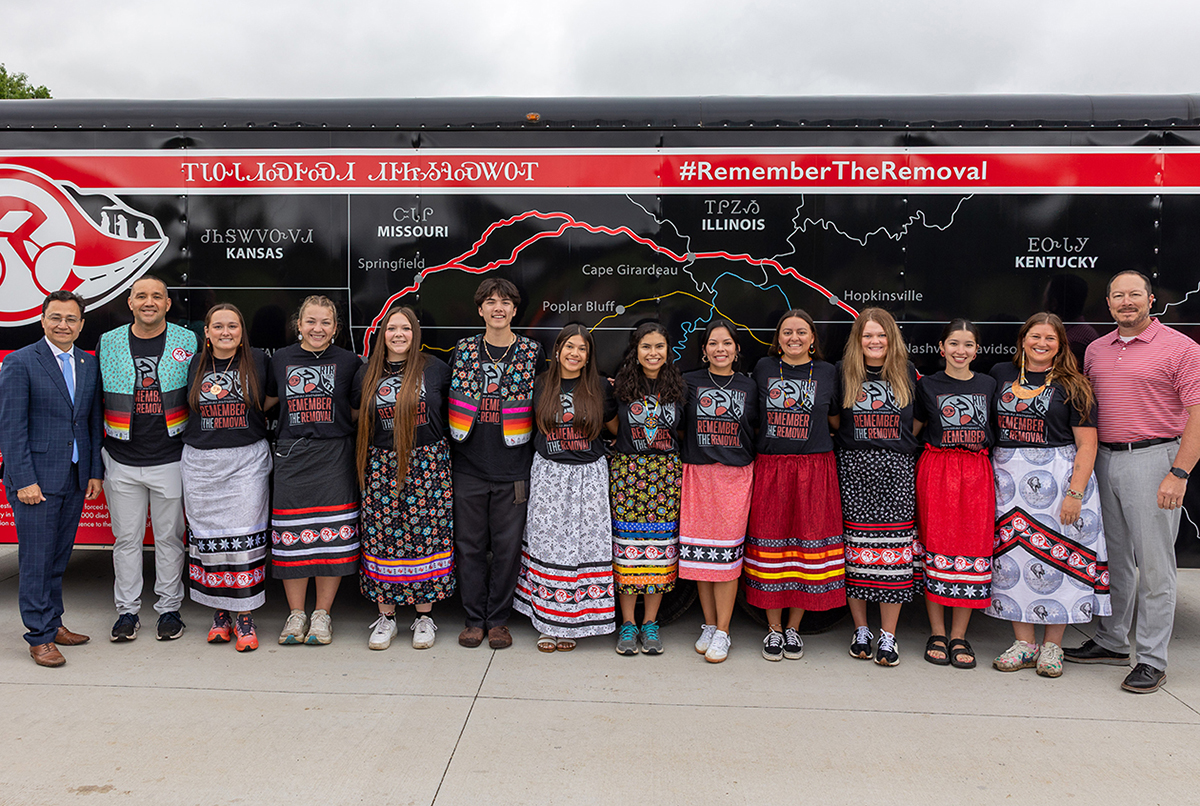TAHLEQUAH, Okla. — The 12 Cherokee Nation Remember the Removal Bike Ride participants left for Cherokee, North Carolina, on May 27 following a send-off ceremony at the Cherokee Nation W.W. Keeler Tribal Complex.
Cherokee Nation Principal Chief Chuck Hoskin Jr., Cherokee Nation Deputy Chief Bryan Warner and other Cherokee Nation leaders joined members of the Council of the Cherokee Nation and family, friends and co-workers of the 12 cyclists to share wishes of success ahead of the weeks-long journey.
The riders will join cyclists from the Eastern Band of Cherokee Indians to train before the ride officially begins on June 2.
“Our Nation is very proud of these 12 riders, who have put in weeks of practice since December. They are well qualified mentally and physically for this challenge,” Chief Hoskin said. “The ride serves as a reminder of one of the darkest chapters in our shared history. Our ancestors suffered a nearly 1000-mile journey, rampant sickness, dispossession and stockades before reaching Indian Territory. These cyclists will visit historic sites which the United States had hoped would be the remnants of our great Nation – but the Indian Removal Act of 1830 and subsequent decisions such as allotment did not break our ancestors. They decided that in spite of everything thrown at them, there was more to be done.”
The Remember the Removal Bike Ride spans approximately 950 miles along the northern route of the Trail of Tears, beginning in New Echota, Georgia, the former capital of the Cherokee Nation, and ending on June 21 in Tahlequah. The northern route of the Trail of Tears spans through Georgia, Tennessee, Kentucky, Illinois, Missouri, Arkansas and Oklahoma.
“I am very proud of the 12 riders who are about to embark on this journey,” said Deputy Principal Chief Bryan Warner. “Visiting these historic sites where we endured hardship will fall heavy on their hearts and minds. I am praying for the riders to find the good in each other during this memorial ride. After months of training, I know they are ready to undertake this journey.”
Cherokee Nation cyclists include AP Anderson, 17, of Bentonville, Ark.; Kalina Campos, 25, of Concord, Calif.; Stephanie Conduff, 42, of Broken Arrow, Okla.; Kacey Fishinghawk, 23, of Tahlequah, Okla.; Adriauna Garcia, 19, of Tahlequah, Okla.; Baylee Gregg, 21, of Grove, Okla.; Jeremy Hamilton, 47, of Tulsa, Okla.; Kiyah Holmes, 25, of Tahlequah, Okla.; Baleigh James-Levy, 22, of Fort Gibson, Okla.; Jenny Kliest, 24, of Stilwell, Okla.; Lexi Melton, 24, of Vinita, Okla. and Mackenzie Teehee, 23, of Stilwell, Okla.
Adriauna Garcia, of Tahlequah will visit sites where her ancestors lived and areas they passed through while on the Trail of Tears.
“I’m feeling all of the emotions but I’m super excited for the journey ahead of me, I really am going to miss my family during the ride,” said Garcia “We’re going to visit the Vann House in Chatsworth, Georgia. Seeing a home one of my ancestors made feels really invigorating. This ride will strengthen the bond between the other cyclists and I, but we will always be Cherokee.”
Before leaving, the cyclists had their family trees mapped out by a professional genealogist, providing them insight into their ancestral past as well as connecting any family links they might share with one another.
Jenny Kliest, of Stilwell, is ready for the journey ahead while bonding with her fellow cyclists.
“We’re heading back home, I’m so excited to start riding and visit with riders from the EBCI team. We’ve trained for hundreds of miles but this a serious task, and as ambassadors of Cherokee Nation I’m looking forward to meeting with historians and community members out east.”
During the bike ride, cyclists will visit several Cherokee gravesites and historic landmarks. Among the sites is Blythe Ferry in Tennessee on the westernmost edge of the old Cherokee Nation, as well as Mantle Rock in Kentucky, where Cherokees spent several weeks during the harsh winter of 1838-1839 waiting for the Ohio River to thaw and become passable.
Of the estimated 16,000 Cherokees forced to march to Indian Territory in the late 1830s, about 4,000 died due to exposure, starvation and disease, giving credence to the name Trail of Tears.
For more information on the Remember the Removal Bike Ride or to follow along during the journey, visit Facebook.com/removal.ride.

